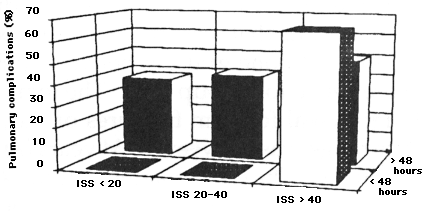
Session V Spine
Review of Pulmonary Complications Associated with Early Versus Late Stabilization of Thoracic and Lumbar Fractures
Mark Brazinski, MD, Jung U. Yoo, MD
Department of Orthopedic Surgery, Case Western Reserve University, Cleveland, Ohio
Hypothesis: There is a difference in the incidence of pulmonary complications related to the timing of surgical stabilization of thoracic or lumbar fractures and dislocations.
Conclusion: Major thoracic and lumbar fractures should be stabilized early to prevent pulmonary complications. Early stabilization was shown to be beneficial to patients with Injury Severity Score (ISS) of less than 40, therefore patients with isolated spine fractures as well as those with other organ system injuries benefits from early stabilization. The percentage of patients with pulmonary complications increases with longer delays in surgical treatment; none of the patients with ISS<40 treated within 48 hours of the injury experienced pulmonary complications. A fifty percent pulmonary complication rate was seen when treatment is delayed greater than 7 days. Because of the small numbers (n=5) in the patients with ISS>40, we cannot conclude either the beneficial or detrimental effects of early surgery.
Materials and Methods: For inclusion into the study, the patient had to sustain a traumatic thoracolumbar spine fracture, be transferred to the treating hospital within 24 hours and undergo operative stabilization of their spine injury (n=47). Of that group, the early treatment group was defined as patients with spine fractures stabilized operatively within 48 hours of injury and the late group was treated after 48 hours.
Injury severity score (ISS) was calculated for each of the patients to determine its relationship to the timing of fixation as well as pulmonary complications. Pulmonary complications were defined as treatment instituted for pneumonia, ARDS, or fat emboli syndrome. The early and late groups were compared in total and then subdivided into three groups depending on ISS score. The first group, with ISS of less than 20, included mostly isolated spine fractures. The group with ISS between 20 to 40 consisted mainly of patients with severe injury to one other organ systems. The third group with ISS greater than 40 included patients with severe injury to two other associated organ systems.
Results: Only two early group patients experienced pulmonary complications, versus the late treatment group with eleven of the twenty seven patients experiencing pulmonary complications (p<0.025). The only early stabilized patients to experience pulmonary complications were two of the three patients in group III suggesting multiple causes for their pulmonary problems.
Because of the uneven distribution of the numbers of the patients in group I and II treated with early or late stabilization, we examined each of these groups separately and statistical tests were performed. The results for all groups are shown in Figure 1. For group I, none of the twelve early treated patients experienced pulmonary complications, compared to three of eight patients (38%) in the late treated group (p<0.05).

Figure 1. Incidence (%) of pulmonary complications in the different patient groups
Similarly, none of the group II's five early treated patients experienced pulmonary complications, compared to seven of seventeen (41 %) late group patients. This difference was not statistically significant, but a strong trend toward better pulmonary outcome is demonstrated with early stabilization (p<0.1). In group III, two of the three early patients had pulmonary complications versus one of the two patients in the delayed treatment group.
The pulmonary complication rate sequentially increases as the surgical stabilization is delayed when group I and II patients are combined. If treated within 48 hours, none of these patients experience pulmonary complication. When the treatment was instituted between 48 hours and seven days then 20% of the patients experienced pulmonary complications. When the stabilization was delayed beyond one week post-injury, 50% of these patients experienced pulmonary complications.
As expected, there was a statistically significant difference in total acute hospital days between the early and late stabilization groups. Total hospital days for the early stabilization group was 15.9±11.2 days versus 23.1±11.1 days (p<0.05). Whether a patient was stabilized early or late, presence of pulmonary complication significantly increased total hospital days (19.9± 13.0 vs 11.4±5.0, p<0.005).